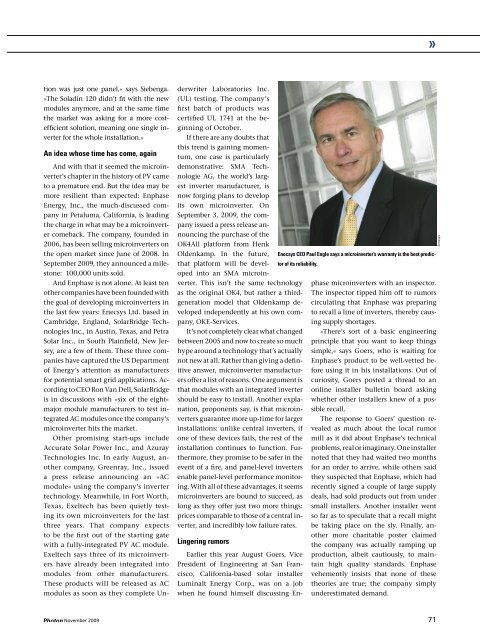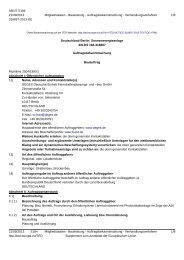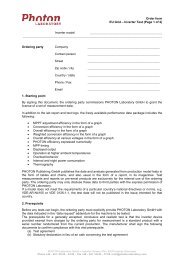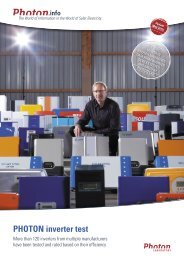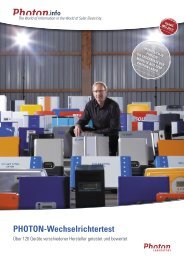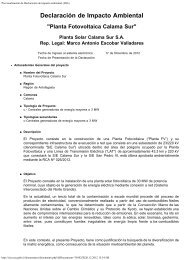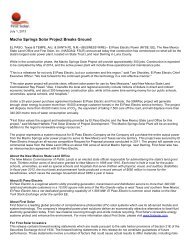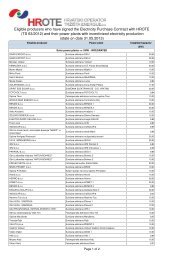INTRODUCTORY SPECIAL INTRODUCTORY ... - PHOTON Info
INTRODUCTORY SPECIAL INTRODUCTORY ... - PHOTON Info
INTRODUCTORY SPECIAL INTRODUCTORY ... - PHOTON Info
Create successful ePaper yourself
Turn your PDF publications into a flip-book with our unique Google optimized e-Paper software.
tion was just one panel,« says Siebenga.<br />
»The Soladin 120 didn’t fit with the new<br />
modules anymore, and at the same time<br />
the market was asking for a more cost-<br />
efficient solution, meaning one single in-<br />
verter for the whole installation.«<br />
An idea whose time has come, again<br />
And with that it seemed the microin-<br />
verter’s chapter in the history of PV came<br />
to a premature end. But the idea may be<br />
more resilient than expected: Enphase<br />
Energy, Inc., the much-discussed com-<br />
pany in Petaluma, California, is leading<br />
the charge in what may be a microinvert-<br />
er comeback. The company, founded in<br />
2006, has been selling microinverters on<br />
the open market since June of 2008. In<br />
September 2009, they announced a mile-<br />
stone: 100,000 units sold.<br />
And Enphase is not alone. At least ten<br />
other companies have been founded with<br />
the goal of developing microinverters in<br />
the last few years: Enecsys Ltd. based in<br />
Cambridge, England, SolarBridge Tech-<br />
nologies Inc., in Austin, Texas, and Petra<br />
Solar Inc., in South Plainfield, New Jer-<br />
sey, are a few of them. These three com-<br />
panies have captured the US Department<br />
of Energy’s attention as manufacturers<br />
for potential smart grid applications. Ac-<br />
cording to CEO Ron Van Dell, SolarBridge<br />
is in discussions with »six of the eight«<br />
major module manufacturers to test in-<br />
tegrated AC modules once the company’s<br />
microinverter hits the market.<br />
Other promising start-ups include<br />
Accurate Solar Power Inc., and Azuray<br />
Technologies Inc. In early August, an-<br />
other company, Greenray, Inc., issued<br />
a press release announcing an »AC<br />
module« using the company’s inverter<br />
technology. Meanwhile, in Fort Worth,<br />
Texas, Exeltech has been quietly test-<br />
ing its own microinverters for the last<br />
three years. That company expects<br />
to be the first out of the starting gate<br />
with a fully-integrated PV AC module.<br />
Exeltech says three of its microinvert-<br />
ers have already been integrated into<br />
modules from other manufacturers.<br />
These products will be released as AC<br />
modules as soon as they complete Un-<br />
derwriter Laboratories Inc.<br />
(UL) testing. The company’s<br />
first batch of products was<br />
certified UL 1741 at the be-<br />
ginning of October.<br />
If there are any doubts that<br />
this trend is gaining momen-<br />
tum, one case is particularly<br />
demonstrative: SMA Tech-<br />
nologie AG, the world’s larg-<br />
est inverter manufacturer, is<br />
now forging plans to develop<br />
its own microinverter. On<br />
September 3, 2009, the com-<br />
pany issued a press release an-<br />
nouncing the purchase of the<br />
OK4All platform from Henk<br />
Oldenkamp. In the future,<br />
that platform will be devel-<br />
oped into an SMA microin-<br />
verter. This isn’t the same technology<br />
as the original OK4, but rather a third-<br />
generation model that Oldenkamp de-<br />
veloped independently at his own com-<br />
pany, OKE-Services.<br />
It’s not completely clear what changed<br />
between 2005 and now to create so much<br />
hype around a technology that’s actually<br />
not new at all. Rather than giving a defin-<br />
itive answer, microinverter manufactur-<br />
ers offer a list of reasons. One argument is<br />
that modules with an integrated inverter<br />
should be easy to install. Another expla-<br />
nation, proponents say, is that microin-<br />
verters guarantee more up-time for larger<br />
installations: unlike central inverters, if<br />
one of these devices fails, the rest of the<br />
installation continues to function. Fur-<br />
thermore, they promise to be safer in the<br />
event of a fire, and panel-level inverters<br />
enable panel-level performance monitor-<br />
ing. With all of these advantages, it seems<br />
microinverters are bound to succeed, as<br />
long as they offer just two more things:<br />
prices comparable to those of a central in-<br />
verter, and incredibly low failure rates.<br />
Lingering rumors<br />
Earlier this year August Goers, Vice<br />
President of Engineering at San Fran-<br />
cisco, California-based solar installer<br />
Luminalt Energy Corp., was on a job<br />
when he found himself discussing En-<br />
November 2009 71<br />
»<br />
Enecsys CEO Paul Engle says a microinverter’s warranty is the best predic-<br />
tor of its reliability.<br />
phase microinverters with an inspector.<br />
The inspector tipped him off to rumors<br />
circulating that Enphase was preparing<br />
to recall a line of inverters, thereby caus-<br />
ing supply shortages.<br />
»There’s sort of a basic engineering<br />
principle that you want to keep things<br />
simple,« says Goers, who is waiting for<br />
Enphase’s product to be well-vetted be-<br />
fore using it in his installations. Out of<br />
curiosity, Goers posted a thread to an<br />
online installer bulletin board asking<br />
whether other installers knew of a pos-<br />
sible recall.<br />
The response to Goers’ question re-<br />
vealed as much about the local rumor<br />
mill as it did about Enphase’s technical<br />
problems, real or imaginary. One installer<br />
noted that they had waited two months<br />
for an order to arrive, while others said<br />
they suspected that Enphase, which had<br />
recently signed a couple of large supply<br />
deals, had sold products out from under<br />
small installers. Another installer went<br />
so far as to speculate that a recall might<br />
be taking place on the sly. Finally, an-<br />
other more charitable poster claimed<br />
the company was actually ramping up<br />
production, albeit cautiously, to main-<br />
tain high quality standards. Enphase<br />
vehemently insists that none of these<br />
theories are true; the company simply<br />
underestimated demand.<br />
Enecsys


